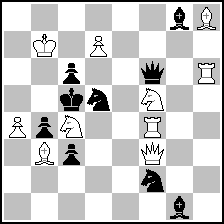
Website founded by
Milan Velimirović
in 2006
17:54 UTC


| |
MatPlus.Net  Forum Forum  General General  s# thematic in #2 s# thematic in #2 |
| |
|
|
|
|
You can only view this page!
| | | (1) Posted by Hauke Reddmann [Thursday, Oct 15, 2009 14:03] | s# thematic in #2
A beloved s# theme is: An effect that was intended to be
good for b(or w) turns out to be good for w(or b).
Strictly speaking, in orthodox n# this can be only justified
by stalemate, and i would hesitate to call a key that lifts
a stalemate position, or a try leading to stalemate, to be a
valid rendering of the theme in the 2#.
But we can always cheat :-)
SCHWALBE 14017 (Reddmann/Paslack) shows the following theme:
White closes a black line, but since another white piece is
behind the black one whose line was closed, he also closes the
same line for himself (comes to effect when the black piece
moves off to parry). (In this problem, this effect after
1.Sd6?/Se5! is used "just" for dual avoidance mate transfer.)
 (= 10+9 ) (= 10+9 )
So, the big question: Can you think of another effect that
could be used in an analogous way? (E.g. interference on a
focus of a black and a white line, but this is even less the
"same" effect.)
Hauke
| | | (2) Posted by seetharaman kalyan [Sunday, Aug 29, 2010 21:04] |
<(E.g. interference on a focus of a black and a white line, but this is even less the"same" effect.)>
Even in the example quoted, the effect of the try and key is "closing of a black AND white line". These two lines just happen to coincide. The closing of the BQ lines does not prove to be beneficial to black; only white uses that shut off.
Perhaps Block problems where the key gives flights to black king come close to showing the effect.
| |
No more posts |
MatPlus.Net  Forum Forum  General General  s# thematic in #2 s# thematic in #2 |
|
|
|
 ISC 2024
ISC 2024 Forum
Forum  General
General  s# thematic in #2
s# thematic in #2 
